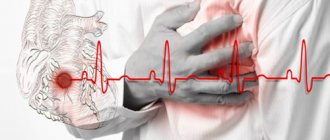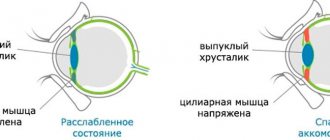First aid for an angina attack
Angina almost always accompanies ischemic heart disease. However, with other cardiovascular diseases (thickening of the heart muscle, anemia), attacks of angina are also recorded. Symptoms primarily include severe chest pain and shortness of breath. And the reasons are oxygen starvation of the heart tissue due to atherosclerotic narrowing of the lumen of the coronary vessels or severe vascular spasm. The trouble is that the disease manifests itself suddenly, so both the patient and his relatives must know what to do during an attack of angina, how to provide first emergency aid. It is worth remembering that this disease is a pre-infarction condition, and therefore requires qualified diagnosis and treatment. Now you can undergo a consultation and a set of preparatory examinations when registering for a course of enhanced external counterpulsation or shock wave therapy of the heart absolutely free of charge!
Promotion
Just until the end of autumn, undergo a free consultation and a set of preparatory examinations* when registering for a course of enhanced external counterpulsation or shock wave therapy of the heart.**
Send a request
* Check the details of the Promotion by phone. **Has contraindications; consultation with a doctor is required.
Enhanced external counterpulsation (EECP) Cardiac shock wave therapy (SWTS)
Hurry up to apply, the promotion period is limited.
Drug treatment of angina: hopes and disappointments
WITH
Modern cardiology is rightfully considered one of the most dynamically developing medical specialties. The rapid development of evidence-based medicine, along with numerous developments of new medications and methods of invasive interventions, leads to the fact that recommendations for the diagnosis and treatment of cardiovascular diseases are regularly updated with new data. At the same time, new methods for detecting and correcting cardiovascular diseases are subject to strict “selection” through rigorous clinical trials with a large number of participants and careful statistical analysis. And only diagnostic and therapeutic interventions that have convincingly proven their effectiveness are recommended for widespread use.
Angina pectoris, as a form of coronary heart disease (CHD), has long been considered one of the main cardiac problems. Of course, this is primarily due to the high prevalence of this disease and the high risk of developing myocardial infarction (MI) and other adverse consequences. In our country, as in many other countries, IHD and its consequences are the main cause of mortality
. Over the past 10–15 years, much has changed in the management of patients with angina. Beyond the scope of this review, the problems of treating unstable and vasospastic forms of angina remain. The main focus will be on new data regarding the drug treatment of stable angina, one of the most resource-intensive areas of modern cardiology.
Goal of treatment for angina pectoris
Treatment of stable angina has two goals. The first is the prevention of the development of MI and death and, accordingly, an increase in life expectancy. The second is a decrease in the frequency and intensity of angina attacks.
(ideally their complete elimination), which improves the quality of life.
From the patient's point of view, the latter goal often has a certain advantage, since it is subjectively perceived as more relevant.
However, the highest priority is given to therapy aimed at reducing the risk of MI and death. Therefore, if different therapeutic strategies are equally effective in alleviating disease symptoms, preference should be given to therapies with proven or very likely benefit in preventing death. The ideal drugs for treating a patient with coronary artery disease and angina are those that simultaneously provide a high quality of life and increase its duration. The choice of treatment often depends on the clinical response to initial drug therapy, although some patients immediately prefer myocardial revascularization procedures (angioplasty and stenting, coronary artery bypass grafting). Therefore, in the decision-making process regarding the choice of treatment, factors such as the cost-effectiveness ratio of the proposed therapy and the patient’s opinion should be taken into account. We should not forget that in many cases, using various methods of restoring coronary circulation, only one of the goals is achieved - eliminating or reducing pain, i.e. improving the quality of life, while regular drug therapy is necessary to prevent further development and progression of atherosclerosis .
Drug therapy to prevent myocardial infarction and death
Antiplatelet agents
In all modern cardiological guidelines, the use of antiplatelet drugs is a mandatory component of the treatment of coronary artery disease and angina pectoris.
, in particular. The main antiplatelet drugs in the arsenal of a modern doctor are aspirin, ticlopidine, clopidogrel.
of acetylsalicylic acid (aspirin) is based on
inhibits cyclooxygenase and platelet thromboxane A2 synthesis.
, the risk of adverse cardiovascular outcomes - MI, sudden death - is reduced
by an average of .
Ticlopidine inhibits platelet aggregation caused by ADP, thrombin, collagen, thromboxane A2 and platelet aggregation factor. In addition, in stable angina, ticlopidine reduces blood viscosity, reducing the concentration of plasma fibrinogen. Long-term use of the drug is limited due to side effects, the most dangerous of which are neutropenia and thrombocytopenic purpura.
Clopidogrel, like ticlopidine, is a thienopyridine derivative, but is superior to ticlopidine in its antithrombotic effect. In comparative studies, clopidogrel was superior to aspirin in reducing the combined risk of MI, vascular death, and stroke among patients with post-infarction cardiosclerosis, stroke, and peripheral atherosclerosis.
CURE Randomized Trial
, which included more than 12,500 patients, convincingly proved the effectiveness of clopidogrel (300 mg/day in the acute period, then 75 mg/day) in combination with aspirin (75–325 mg/day) in preventing (on average 20%) the likelihood of heart attack and stroke and death from cardiovascular complications in patients with unstable angina and other acute coronary syndromes.
Recently, this drug was recommended by the American Food and Drug Administration as a drug of choice in the intensive care of acute coronary syndromes. However, the advisability of prescribing clopidogrel for stable angina in randomized prospective studies has not yet been sufficiently studied. Despite the CAPRIE
a reduction in the combined risk of cardiovascular complications during long-term use of clopidogrel, the widespread use of this drug for coronary artery disease is still hampered by the unclear risk-benefit ratio with long-term use, as well as the relatively high cost. It should also be remembered that although clopidogrel is less likely than aspirin to cause dangerous gastrointestinal bleeding, taking clopidogrel is 30% more likely to cause diarrhea and skin rashes.
The results of a meta-analysis of the comparative effectiveness and safety of prescribing various doses of aspirin for the purpose of long-term secondary prevention of cardiovascular complications are interesting (Table 1).
Considering the widespread prescription of aspirin for long-term use for a variety of cardiovascular diseases (including the elderly), questions of the safety of therapy with this drug become very relevant. It should be noted that a special prospective study on the comparative assessment of different doses of aspirin is only being planned. However, data obtained earlier and summarized in a meta-analysis indicate that when taking small doses of aspirin (75–150 mg/day), all platelet cyclooxygenase is almost completely blocked after a few days, which ensures the antithrombotic effect of the drug. Taking medium (160–325 mg/day) and high (500–1500 mg/day) doses of aspirin does not enhance its antithrombotic activity and, accordingly, does not increase the preventive feasibility of taking it. Along with this, medium and high doses of aspirin cause significantly more frequent complications (usually gastrointestinal bleeding, including life-threatening ones).
It appears that low-dose aspirin (75–150 mg/day) should be prescribed to stable patients until solid evidence is available for secondary prevention of vascular complications.
, and in acute vascular complications (unstable angina, MI) and invasive interventions on the coronary arteries (angioplasty, stenting, atherectomy), when a rapid antiplatelet effect is required, it is necessary to use higher doses (>325 mg/day) - followed by a decrease to reduce risk of hemorrhagic complications.
Anticoagulants
Small placebo-controlled studies have examined the effect of daily subcutaneous administration of low molecular weight heparin in patients with stable angina. A decrease in plasma fibrinogen levels, an improvement in exercise tolerance, an increase in the time of exercise before the appearance of signs of ischemia on the ECG, and a decrease in the amplitude of ST segment depression on the ECG were demonstrated. But clinical experience with such therapy is still small, and its effect on prognosis has not been studied. More modern drugs, recombinant hirudin and platelet IIb/IIIa receptor antagonists, have also not demonstrated effectiveness in clinical studies in patients with stable angina. Therefore, these drugs should not yet be recommended for widespread use in stable angina.
Taking indirect anticoagulants in the absence of antiplatelet therapy
The effectiveness of indirect anticoagulants in ischemic heart disease was assessed in a meta-analysis of 20 randomized clinical trials. In 16 of these studies, patients received high-dose anticoagulants (INR>2.8) (total of 1056 patients), and in 4 studies medium-dose anticoagulants were prescribed (total of 1365 patients). No studies included concomitant regular antiplatelet therapy. It turned out that against the background of high doses of anticoagulants, the combined risk of developing myocardial infarction and stroke was significantly lower than in the control groups (reduced odds of development – 43% with a 95% confidence interval of 37–49%, reduction in absolute risk 9.8%) . The effect of average doses of anticoagulants was smaller and statistically insignificant. In a direct comparison of high- and medium-dose anticoagulants with aspirin, there was no difference in the effect on mortality and the combined risk of myocardial infarction and stroke (odds ratio 1.04, 95% confidence interval 0.80–1.34). However, compared with placebo, high-dose anticoagulants were associated with an almost sixfold increase in the incidence of major (usually intracranial) bleeding (odds ratio 6.0, 95% confidence interval 3.3–17.6). Compared with aspirin, prophylactic anticoagulants increased the risk of major bleeding by almost 2-fold (odds ratio 2.4, 95% confidence interval 1.6–3.6).
Thus, isolated use of high doses of anticoagulants is accompanied by a significant reduction in the risk of cardiovascular complications in coronary artery disease. Due to the fact that the risk of severe bleeding exceeds that while taking antiplatelet agents, constant monitoring of patients and monitoring of coagulograms is necessary. Taking low to medium doses of aspirin is as effective as taking anticoagulants
, however, the risk of complications of antiplatelet therapy is much lower, and it is easier to monitor patients taking aspirin.
The frequency of bleeding against the background of various doses of aspirin is presented in Table 2. Taking indirect anticoagulants in combination with antiplatelet agents
The same meta-analysis assessed the effectiveness of the combination of indirect anticoagulants and antiplatelet agents in the secondary prevention of coronary artery disease. A total of 6 randomized studies with a total number of 8915 participants were reviewed. In 3 studies (8435 patients), taking low doses of anticoagulants (INR <1.5) did not lead to a significant change in the combined risk of MI and stroke (odds ratio 0.91 with 95% confidence interval 0.79–1.06). At the same time, an unreliable increase in the risk of severe bleeding was shown when combining aspirin with low and high doses of indirect anticoagulants. In the remaining studies, where patients received more active anticoagulant therapy (INR 2–3), the sample size was insufficient (480 patients) to calculate the effectiveness and safety of treatment. Several randomized clinical trials are currently investigating this issue.
The same meta-analysis assessed the effectiveness of a combination of indirect anticoagulants and antiplatelet agents in the secondary prevention of coronary artery disease. A total of 6 randomized studies with a total number of 8915 participants were reviewed. In 3 studies (8435 patients), taking low doses of anticoagulants (INR <1.5) did not lead to a significant change in the combined risk of MI and stroke (odds ratio 0.91 with 95% confidence interval 0.79–1.06). At the same time, an unreliable increase in the risk of severe bleeding was shown when combining aspirin with low and high doses of indirect anticoagulants. In the remaining studies, where patients received more active anticoagulant therapy (INR 2–3), the sample size was insufficient (480 patients) to calculate the effectiveness and safety of treatment. Several randomized clinical trials are currently investigating this issue.
Lipid-lowering drugs
To date, there is no doubt that a decrease in plasma cholesterol levels with a high risk of complications of coronary artery disease is accompanied by a significant decrease in the risk of cardiovascular complications, including fatal ones, as well as a decrease in overall mortality. Among all methods of drug monotherapy, HMG-CoA reductase inhibitors (statins) most effectively reduce both cholesterol levels and the risk of cardiovascular complications
. The last decade has been marked by an avalanche-like accumulation of evidence of the beneficial effect of statins on morbidity and mortality rates in a variety of categories of patients - men, women, with concomitant diabetes, atherosclerosis of peripheral and cerebral arteries, etc. This has led medical practitioners to become more proactive in prescribing statins. However, there is evidence that many categories of patients are “undertreated” with statins, largely due to the lack of convincing evidence of the effectiveness of this class of drugs in women, in the elderly, and with initially normal and low plasma cholesterol levels. Questions also remain unclear about the doses at which statins should be prescribed, as well as the comparative effectiveness of various drugs.
To date, the most data has been obtained on the secondary prevention of coronary artery disease with pravastatin and simvastatin.
As part of the meta-study The Prospective Pravastatin Pooling project
A cumulative analysis of the results of 3 large prospective randomized trials of pravastatin in the primary and secondary prevention of coronary artery disease was conducted. The effectiveness of pravastatin in secondary prevention was assessed in a total of 13,173 patients treated with pravastatin 40 mg/day for 5 to 6 years. Among those taking pravastatin, there was a reduction in overall mortality to 7.9% versus 9.8% in the placebo group (a relative risk reduction of death of 20% with a 95% confidence interval of 12–27%). In addition, pravastatin reduced the risk of coronary death by 24% (95% confidence interval 14–33%).
A new stage in the prevention of cardiovascular diseases was the results of the use of simvastatin for primary and secondary prevention of cardiovascular diseases and complications in the Heart Protection Study (HPS)
, which will have a significant impact on the management strategy of patients suffering from angina pectoris.
Angiotensin-converting enzyme inhibitors
ACE inhibitors (ACE inhibitors) have not confirmed direct anti-ischemic effectiveness, although this group of drugs is used very widely in the treatment of angina attacks provoked by increased blood pressure.
A review of randomized clinical trials (with a total of 5966 participants) found convincing evidence that the use of ACE inhibitors for left ventricular dysfunction after myocardial infarction significantly reduces mortality, the rate of hospitalization for congestive heart failure, and the risk of recurrent nonfatal myocardial infarction compared with placebo. The effectiveness of the use of ACE inhibitors after MI in the absence of left ventricular dysfunction or in patients with stable coronary artery disease without clinical manifestations of circulatory failure has not yet been sufficiently studied. HOPE trial
(9297 patients with a high risk of developing cardiovascular complications, average follow-up period of 4.7 years) indicate a beneficial effect of ramipril at a dose of 10 mg/day on the main indicators of morbidity, overall and cardiovascular mortality and on the need for myocardial revascularization.
This issue is currently being investigated in two large multicenter studies. In the PEACE
During a 5-year follow-up, the addition of the ACE inhibitor trandolapril 4 mg or placebo to standard therapy in more than 8000 patients with stable coronary artery disease without left ventricular dysfunction (ejection fraction more than 40%) and its effect on such “hard” endpoints as death from heart disease –vascular causes and MI.
Another major study, results expected in 2003, is EUROPA.
.
In 10,500 patients with coronary artery disease without significant left ventricular dysfunction, the effect of long-term (more than 3 years) treatment with perindopril, an inhibitor with high specificity for tissue ACE, is being studied. The primary objective of the EUROPA trial is to evaluate the effect of perindopril at a daily dose of 8 mg on the composite endpoint of all-cause death, nonfatal myocardial infarction, unstable angina, and cardiac arrest followed by successful resuscitation. A wide range of cardiovascular complications (death from cardiovascular causes, heart failure, the need for myocardial revascularization procedures, stroke, etc.) was selected as secondary goals. As part of this study, to study the mechanisms of the beneficial effect of ACE inhibitors in this category of patients, 2 fragments are planned - PERSPECTIVE and PERFECT, which will clarify the mechanisms of the beneficial effect of ACE inhibitors on the development of atherosclerosis. PERSPECTIVE
trial will evaluate the effect of perindopril on coronary artery wall structure as measured by quantitative coronary angiography and intravascular ultrasound (IVUS). In this study, using the most accurate assessment method to date, IVUS, the effect of perindopril on the progression of coronary atherosclerosis over 3 years will be studied in 400 patients with stable coronary artery disease without signs of left ventricular dysfunction.
PERFECT Study
will study the effects of perindopril on brachial artery endothelial function in 300 patients. Flow-dependent dilatation of the brachial artery using high-resolution ultrasound will be determined before randomization and after 6, 12, 24 and 36 months of treatment with perindopril or placebo. The primary purpose of this excerpt will be to assess the percentage of change in flow-dependent dilatation of the brachial artery between baseline and 36 months of follow-up, as well as the percentage of change in the severity of brachial artery vasoconstriction due to neurohormonal activation during the cold test at the same time. These studies will help to definitively determine the place of ACE inhibitors in the treatment of patients with stable angina without impairment of the functional state of the left ventricle in order to improve the prognosis.
Hormone replacement therapy with estrogen
Many early observational studies showed that the administration of isolated or combined hormone therapy with estrogens and progestins to postmenopausal women with signs of coronary artery disease reduces the severity of risk factors for coronary artery disease (normalizes plasma lipids) and the risk of adverse complications of coronary heart disease by 35–80%. However, in the large prospective placebo-controlled HERS
(2763 postmenopausal women with coronary artery disease, follow-up period 4.1 years), the administration of combined hormone replacement therapy did not lead to a significant reduction in the risk of developing unstable angina, congestive heart failure, circulatory arrest, transient cerebrovascular accident, peripheral arterial thrombosis, non-fatal myocardial infarction, general mortality and mortality from ischemic heart disease. Hormone replacement therapy also did not reduce the need for myocardial revascularization. The isolated use of estrogens without progestins for the prevention of coronary artery disease has not been studied in randomized clinical trials.
At the same time, long-term use of estrogens was more often accompanied by the development of peripheral venous thrombosis and pulmonary embolism, endometrial and breast cancer, as well as gallbladder diseases.
Nitrates
Many doctors traditionally begin treatment of angina by prescribing nitrates, which are available in various dosage forms. These drugs improve exercise capacity, increase the time to onset of angina, and reduce ST segment depression on the exercise ECG. The disadvantage of nitrates is the development of tolerance to them and side effects that make their use difficult. It is also unknown whether nitrates improve the prognosis in patients with stable angina with long-term use, which makes the advisability of their use in the absence of angina pectoris (myocardial ischemia) questionable. In many cases, nitrates are used during periods of deterioration or when additional stress is expected (on demand).
b-blockers
β-blockers reduce heart rate and blood pressure during exercise, delay or prevent the development of pain and ischemic ECG changes. When selecting a dose, they are guided by the frequency of attacks; usually they try to slow down the heart rate to 55–60 beats/min. In the absence of contraindications
(and there are quite a lot of them)
we should strive for the mandatory prescription of b-blockers to all patients with stable angina
, since it is assumed (albeit less proven than after MI) that they have a beneficial effect on the prognosis. The previously described negative metabolic effects of b-blockers (deterioration of lipid parameters) are usually insignificant and are most often not taken into account. New members of the β-blocker class with additional vasodilator, antioxidant, and endothelial protectant properties are generally better tolerated and have a more favorable metabolic profile, but it is not yet known to what extent these benefits are realized with long-term use. The need to monitor the prescription of b-blockers and the side effects encountered lead to the fact that doctors do not always use this valuable class of drugs.
Calcium antagonists
Usually prescribed when the antianginal effect of nitrates or b-blockers is insufficient. Calcium antagonists are especially indicated for the treatment of vasospastic angina.
.
These are drugs with different hemodynamic effects (the group of dihydropyridines and drugs with rhythm-slowing effects verapamil and diltiazem) and, accordingly, a spectrum of side effects, which must be taken into account when choosing a drug. For long-term treatment of angina from dihydropyridine derivatives, it is recommended to use only long-acting dosage forms or long-acting new generations of calcium antagonists ( amlodipine
).
In addition, the use of amlodipine
is particularly effective for controlling increased blood pressure and treating arterial hypertension, which is a risk factor for the development of coronary artery disease.
Short-acting forms of nifedipine are not indicated for the treatment of patients with coronary artery disease. It is also necessary to take into account the negative inotropic effect of diltiazem and verapamil and avoid their use in patients with impaired left ventricular systolic function and especially in clinical manifestations of heart failure. Although a beneficial effect of calcium antagonists on the course of atherosclerosis (prevention of the development of new atheromas) is expected, evidence of an improvement in the prognosis of patients with angina pectoris with their regular use is not yet available. This issue is being studied in large studies - CAMELOT
(amlodipine),
ACTION
(nifedipine SL, GITS),
INVEST
(verapamil).
Other antianginal agents
Nicorandil is an activator of ATP-dependent potassium channels. Developed in 1984 in Japan, it is used for angina pectoris in European countries. Similar to nitrates in terms of the mechanism of venodilating action, it also has the properties of an arteriolodilator - through its effect on ATP-dependent potassium channels in the cell membrane. In experimental and clinical observations, nicorandil
has repeatedly demonstrated anti-ischemic properties, which were explained by its ability to “adapt” the myocardium to prolonged episodes of ischemia.
The IONA trial, a large, randomized, placebo-controlled trial, was conducted in the UK to test the effect of nicorandil on clinical outcomes in angina.
(Impact Of Nicorandil in Angina), which involved 5126 patients with stable angina (mean age 67 years, 24% women) and various associated cardiovascular risk factors (left ventricular hypertrophy, arterial hypertension - 46%, left ventricular systolic dysfunction , diabetes mellitus – 8%). 89% of patients included in the study had functional class I–II angina (according to the NYHA classification). In addition to antiplatelet agents, antianginal (b-blockers, calcium antagonists) and lipid-lowering therapy (statins) and ACE inhibitors, according to indications, study participants received nicorandil (40 mg/day in 2 doses) or placebo for 12–36 months (average 1 ,6 years). The summary primary endpoint was death from coronary artery disease, nonfatal myocardial infarction, and hospitalization for angina. Secondary endpoints were death from coronary artery disease and nonfatal myocardial infarction. Nicorandil significantly (by 17%) reduced the risk of the primary endpoint, mainly due to a reduction in the incidence of acute coronary syndromes without MI (by 21%) and the total number of cardiovascular complications (14%). Overall mortality did not change significantly during treatment with nicorandil, although a tendency towards its decrease was noted (by 15%). One of the side effects when taking nicorandil is headache.
Metabolic drugs
Recently, there has been significant interest in the metabolic approach in the treatment of stable angina. This approach allows you to avoid adverse consequences when prescribing or increasing doses of hemodynamic active agents (nitrates, b-blockers, calcium antagonists) in the form of a decrease in blood pressure, bradycardia, etc. A number of controlled studies have shown that trimetazidine
, so far the only approved drug of this group for the treatment of angina, both in monotherapy and in combination with any class of antianginal drugs, not only reduces the number of angina attacks and the need for nitroglycerin, but also significantly increases the duration of physical activity and the time until the onset of segment depression ST on ECG.
Recently, the mechanism of action of trimetazidine has been more precisely established - selective inhibition of “long-chain” 3-ketoacyl-CoA thiolase, an enzyme involved in the oxidation of free fatty acids, and this class is called 3-CAT inhibitors
.
A new dosage form of the drug, trimetazidine MB
, prescribed 35 mg twice a day, should significantly increase patient adherence to treatment.
Another representative of this group is ranolazine
, a partial inhibitor of fatty acid oxidation, was evaluated in 2 clinical placebo-controlled studies - as monotherapy at doses of 500 mg, 1000 mg and 1500 mg twice daily (
MARISA
) and as part of combination therapy when added to other antianginal agents in doses of 750 mg and 1000 mg 2 times a day (
CARISA
). By the 12th week of administration, ranolazine, according to the treadmill test, increased the time of pain-free walking, the total time of physical activity and the time until the appearance of ischemic changes on the ECG. A small but significant dose-dependent increase in the duration of the QT segment on the ECG was noted, although not accompanied by clinically significant rhythm disturbances. The study of the safety and tolerability of ranolazine, as well as its effect on the prognosis of stable angina, is currently ongoing (the drug has not yet been registered).
Thus, in the doctor’s arsenal for the successful treatment of a patient with stable angina, there are many drugs with proven clinical effects, including a beneficial effect on the prognosis.
Literature:
1. “Evidence-based medicine.” Annual directory. Issue 1. Moscow, MediaSphere Publishing House, 2002. P.140–184
2. Effects of clopidogrel in addition to aspirin in patients with acute coronary syndromes without ST–segment elevation. N Engl J Med, 2001 Aug 16; 347(7):494–502
3. CAPRIE Steering Committee. Clopidogrel vs Aspirin in Patients at Risk of Ischemic Events A randomized, blinded trial of clopidogrel versus aspirin in patients at risk of ischemic events (CAPRIE). Lancet 1996;348:1329–39
4. Collaborative meta-analysis of randomized trials of antiplatelet therapy for prevention of death, myocardial infarction and stroke in high risk patients. BMJ 2002 Jan 12;324(7329):71–86
5. Hankley GJ, Sudlow CLM, Dunbabin DW, et al “Thienopiridine derivatives (ticlopidine, clopidogrel vs aspirin) for preventing stroke and other serious vascular events in high vascular risk patients” In: The Cochrane Library, Issue 2, 2000. Oxford: Update Software
6. Anand SS, Yusuf S “Oral anticoagulant therapy in patients with coronary artery disease: a meta-analysis” JAMA, 1999;282:2058–2067
7. Flatber M, Kober L, Pfeffer MA, et al “Metaanalysis of individual patient data from trials of long-term ACE-inhibitor treatment after acute myocardial infarction (SAVE, AIRE and TRACE studies)” Circulation, 1997;96(suppl 1 ):I–706
8. The Heart Outcomes Prevention Evaluation (HOPE) Investigators. Effects of angiotensin–converting enzyme inhibitor, ramipril, on cardiovascular events in high–risk patients. N Engl J Med 2000;342:145–153
9. Hulley S, Grady D, Bush T. et al “Randomized trial of estrogen plus progestin for secondary prevention of coronary heart disease in postmenopausal women.” JAMA 1998;280:605–613
10. The LIPID Study Group. Prevention of cardiovascular events and death with pravastatin in patients with coronary heart disease and a broad range of initial cholesterol levels. N Engl J Med 1998;339:1349–1357
11. Simes J, Furberg CD, Braunwald E, et al “Effects of pravastatin on mortality in patients with and without coronary heart disease across a broad range of cholesterol levels. The Prospective Pravastatin Pooling project" Eur Heart J, 2002; 23(3):207–215
12. Shepherd J, Cobbe SM, Ford I, et al. “Prevention of coronary heart disease with pravastatin in men with hypercholesterolaemia.” N Engl J Med 1995;333:1301–1307
13. Sacks FM, Pfeffer MA, Moye LA, et al “The effect of pravastatin on coronary events after myocardial infarction in patients with average cholesterol levels.” N Engl J Med 1996;335:1001–1009
14. Zhilyaev EV, Urzhumova TV, Glazunov AV, et al. “Clinical aspects of the use of trimetazidine (preductal) as an antianginal drug” Ter. Archive 2000;72(8):20–3
15. Zaslavskaya RM, Kelimberdieva ES, Komissarova IA, et al. “Comparative effectiveness of combination therapy with preductal and a combination of amino acids in elderly patients with coronary heart disease and angina pectoris of functional class II–III” Ter. Archive 1999;71(11):58–61
16. “The IONA Study Group. Effect of nicorandil on coronary events in patients with stable angina: the Impact Of Nicorandil in Angina (IONA) randomized trial" The Lancet 2002;359(9314):1269–1275
17. ACC/AHA/ACP–ASIM Guidelines for the management of patients with chronic stable angina. J Am Coll Cardiol 1999;33(7):2081–2118
18. Melandri G, Semprini F, Cervi V, et al “benefit of adding low-molecular weight heparin to the conventional treatment of stable angina pectoris. A double-blind randomized placebo-controlled trial.” Circulation 1993;88:2517–23
19. Van der Bos AA, Deckers JW, Heyndricks GR, et al. “Safety and efficacy of recombinant hirudin vs heparin in patients with stable angina undergoing coronary angioplasty.” Circulation 1993;88:2058–66
20. Simoons ML, Vos J, de Feyter PJ, et al. EUROPA substudies, confirmation of pathophysiological concepts. Eur Heart J 1998; 19 (Suppl J): 56–60.
21. The HOPE Study Investigators. Effects of an angiotensin–converting enzyme inhibitor, ramipril, on death from cardiovascular causes, myocardial infarction, and stroke in high–risk patients. N Engl J Med 2000; 342:145–53.
22. Pfeffer MA, Domanski M, Rosenberg Y, et al. Prevention of events with angiotensin–converting enzyme inhibition (the PEACE study design). Am J Cardiol 1998; 82(Suppl H): 25–30.
23. Fox KM, Henderson JR, Bertrand ME, et al. The European trial on reduction of cardiac events with perindopril in stable coronary artery disease (EUROPA). Eur Heart J 1998; 19 (Suppl J): 52–55
Signs of an angina attack
Since the vessels supplying blood to the heart are narrowed due to atherosclerotic plaques, only a small physical or emotional stress is enough for the heart muscle to feel a lack of oxygen and nutrients. At this time, lactic acid is produced in the tissues, which causes pain.
If, after you have worked physically or been over-excited, you experience heart pain, know that these are the first signs of illness. As it develops, less and less stress will be required to cause an attack. In severe cases, signs of angina appear when walking at an average pace for a distance of 200 meters or climbing one floor.
Diagnosis of the disease
Diagnostics begins “from the threshold.” The first step is to collect an anamnesis and interview the patient about the nature of the attack, the duration of the course, and the intensity of the pain syndrome. What actions of the patient or nervous disturbances are the impetus for the occurrence of angina pectoris. The physical condition of the person (including weight) is necessarily assessed, blood pressure is measured and heart rate is calculated. Then the CBC (complete blood count) is examined, including biochemical analysis and blood sugar. An ECG is performed to determine the degree of cardiac ischemia.
Holter monitoring is possible - a monitor is attached to the patient for a day, which shows the work of the heart. Based on the daily readings of the device, the type of cardiac dysfunction, the frequency of attacks and their duration are determined.
For more severe cases, coronary angiography is performed to diagnose the condition of the vessels. The degree of vasoconstriction and the presence of atherosclerotic lesions are revealed. During this study, an X-ray examination of the heart vessels is performed during the administration of a contrast agent.
In addition to the above, stress tests are sometimes performed on a bicycle ergometer. The doctor evaluates the work of the heart under stress.
Symptoms of an angina attack
External signs of the disease are similar to the symptoms of vegetative-vascular dystonia, pinched nerve, osteochondrosis, pleurisy, so you should know how an angina attack differs from them.
Often the manifestations are quite individual. In different patients, an attack can last 1-15 minutes. And even pain is perceived in different ways: as sharp, squeezing, aching, radiating to the jaw, shoulder, throat, accompanied by a burning sensation.
Painful sensations occur:
- when walking fast, climbing stairs;
- physical activity (especially after a heavy meal);
- emotional tension, excitement, worries, stress;
- sudden movement from a warm room to a cold one;
- at rest at night.
An attack of angina is accompanied by additional symptoms and signs. If, when pain occurs, your eyes darken, profuse sweat appears, your limbs become cold, you feel that you are about to faint, call a doctor immediately - first emergency aid is necessary! In women, these symptoms include stomach pain with nausea and heartburn, shortness of breath and a feeling of weakness.
Angiotensin-converting enzyme inhibitors (ACEIs)
Angiotensin-converting enzyme inhibitors
(ACEI) - for angina pectoris, they are prescribed to prevent the development of heart failure. Therefore, drug doses are usually lower than for the treatment of hypertension. If after a MI you develop symptoms of heart failure or doctors identify impaired LV function, adding an ACE inhibitor to your therapy will significantly reduce the risk of death and the likelihood of a recurrent MI. The effect of drugs such as ramipril, trandolapril, zofenopril, enalapril has been proven. If these drugs are poorly tolerated, replacement with angiotensin receptor antagonists is possible.
ACE inhibitors can be prescribed for angina pectoris without a history of heart attack - their ability to slow the progression of atherosclerosis has been proven. The effect of the drugs ramipril and perindopril has been proven.
First aid for an angina attack
Has the disease manifested itself for the first time? The most correct decision would be to call an ambulance. If you have an attack of angina, the signs and symptoms of which appear during walking or physical exertion, stop immediately and rest. It is best to take a comfortable position, sitting or lying down, and take nitroglycerin, which is usually used to relieve angina attacks.
If you take nitroglycerin 3 times, and it does not give the usual relief in 20 minutes - the symptoms do not go away, then you are close to a heart attack and require immediate medical help, possibly with transfer to intensive care.
Emergency care for symptoms of an angina attack also includes self-massage - it helps relieve acute pain, tension and an instinctive feeling of fear. Massage the left chest, neck, and back of the head. Pay attention to the knee, shoulder, and wrist joints.
The heart is pressing - pills that help
Pressing pain behind the sternum is relieved with tablets from the nitrate group of drugs (Nitroglycerin). In accordance with the generally accepted classification of cardiac drugs, you can choose different cardiac drugs as prescribed by your doctor.
For this purpose, the patient needs to call an ambulance. Before the doctor arrives, you can take 1 tablet with an interval of 5 minutes:
- Nitroglycerin under the tongue, sublingually;
- Aspirin Cardio tablet crushed into powder inside, orally;
- Or analogues of this drug - Acetylcardio-Lect, Thrombopol, Aspicard, Trombogard, Aspinat, CardiAsk and others.
Further treatment will be prescribed by a cardiologist after a comprehensive examination of the patient. Complaints include pressing pain in the heart area, radiating to the left arm and little finger, lack of oxygen, convulsions, nausea, panic and fainting.
How to relieve an angina attack at home?
If an attack occurs while you are lying down, you need first aid. First of all, they helped you sit down and lower your legs down. Unbutton your collar, ask them to open a window in the house, apartment, or other room where you are and take nitroglycerin.
If you feel weak, pale, or have cold sweats, measure your blood pressure. If it is reduced, there is no need to take nitroglycerin. In this case, it is better to relieve the attack with aspirin. But the effect of validol is causing controversy in the world of medicine: doctors are increasingly inclined to believe that it is ineffective.
To provide effective first aid during an angina attack, always keep baralgin, sedalgin, and analgin in your first aid kit. If you have symptoms such as headaches, take one of these medications. For elevated heart rates, anaprillin is recommended.
Popular drugs for heart pain
The classification of cardiac drugs includes drugs that relieve acute pain and various painful sensations in the heart area. These include:
- Antiarrhythmics, Panangin or Asparkam, Cordarone, Amiodarone, Cardiodarone;
- Anticoagulants: Angioks, Heparin sodium, others;
- Acetylsalicylic acid (Aspirin), Valsartan;
- β-blockers: Sotalol, Timolol, Concor, Biprol, containing Bisoprolol and others.
These medications are prescribed after a heart attack.
Popular drugs include:
- Valerian, Corvalol (drops and tablets p/o) with a pronounced sedative effect.
- Nitroglycerin, Validol, Cormentol with a moderate vasodilator effect.
- Novo-passit, Persen-cardio with sedative and antiarrhythmic effects.
- Kratal, Cardiplant, stimulating myocardial activity.
- Panangin, Asparkam contains potassium and magnesium salts of aspartic acid, indicated for combination therapy of coronary artery disease, heart failure, arrhythmias in case of overdose of cardiac glycosides.
Rules for taking nitroglycerin
As part of first aid for an angina attack, you can use both tablets (to relieve an attack outside the home) and drops. The medicine is dropped onto a piece of sugar, which is placed under the tongue and wait until it dissolves. Check the dosage with your doctor, but remember: you cannot take more than 3 tablets (drops) in 15 minutes.
You may feel dizzy, because the effect of the medicine is to dilate blood vessels and reduce pressure. Therefore, before taking, take a comfortable position, sitting or lying down.
How to relieve acute pain in the heart
First aid medications are designed for different types of heart pain - sharp and burning, dull and pressing, intermittent and arising under the influence of stress.
- Validol is applied under the tongue, it dissolves slowly and has an effect in a condition characteristic of a panic attack. The patient complains of pain in the heart area, malaise, lack of air, cold sweat.
- Nitroglycerin is also available without a prescription and is effective for attacks of chest pain and the development of coronary heart disease. The tablet or capsule is taken under the tongue, so it is absorbed into the blood faster. If necessary, you can put another one, the effect occurs in 3 – 5 minutes. It is forbidden to take more.
- Corvalol tablets, drops in a bottle can also be bought without a prescription. The complex composition includes ethyl bromizovalerianate, peppermint oil, and phenobarbital. Take 20 drops per glass of water or one tablet also under the tongue. Relieves pressing pain in the heart, also relieves stabbing and cutting pain, a feeling of heaviness.
- Cardiket tablets with a prolonged effect contain isosorbide dinitrate, which has a pronounced vasodilating effect. It relieves arterial spasm, lowers blood pressure, and has a long-lasting effect.
- Novo-passit is a sedative, available in tablets and syrup, prescribed for vague pain in the heart area, with the appearance of anxiety, depression. They are also used in complex therapy in case of cardiac pathologies. It is prohibited to use by drivers of vehicles, as well as with alcohol.
Why is it important to see a doctor?
Even if there was only one attack, this is a sufficient reason to undergo diagnostics in a qualified cardiology clinic. Angina pectoris can lead to myocardial infarction and even death. Only an experienced cardiologist will promptly identify the problem and prescribe treatment that will help you avoid the fatal risk.
You will receive the full range of qualified cardiological services for the diagnosis, treatment and prevention of cardiovascular diseases at the CBCP Center for Circulatory Pathology, equipped with expert-class European equipment.
Palpitations, how to relieve them
Increased or slowed heart rate, as well as extrasystole, do not always indicate the formation of a pathological process. Perhaps there is an acute lack of oxygen for cardiac activity, the person feels panic, excitement, and stress. There may not be an urgent need to correct the functioning of the cardiovascular system with various drugs.
In more severe cases, treatment is prescribed:
- antiarrhythmic drugs;
- β-blockers;
- ARBs (angiotensin receptor blockers);
- surgery for implantation of a pacemaker is indicated.







